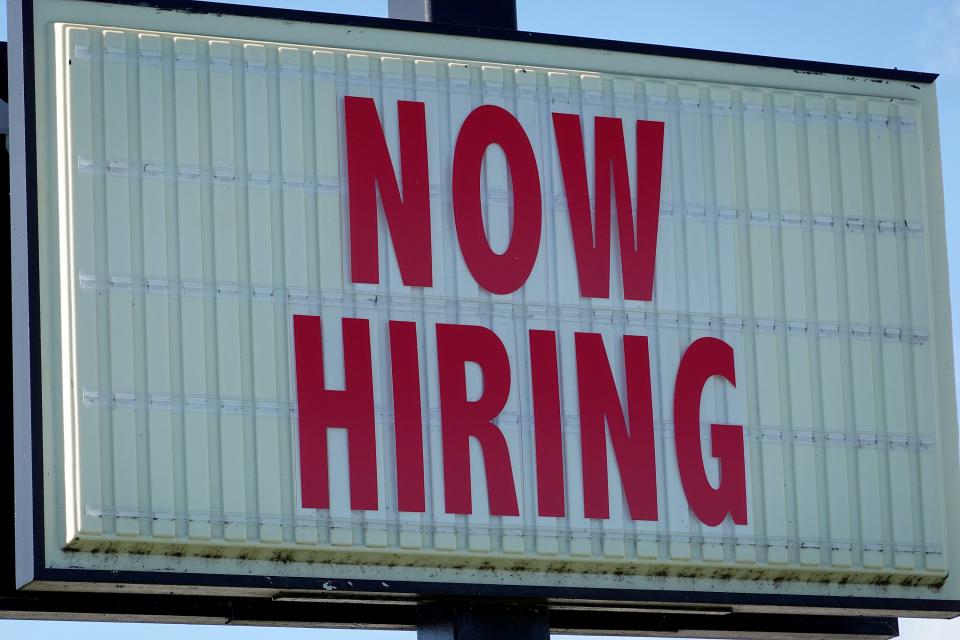Why is the economy so strong? New hires are spending more and upgrading their lifestyles
Economists have been scratching their heads over how Americans can continue to prop up the economy with their spending despite high interest rates, persistent inflation, dwindling savings and rising debt.
There may be a simple answer: Jobs.
Payroll growth has been stunningly strong this year. Most people who land new jobs have been opening their wallets, with many making big lifestyle changes that include buying a new house or car, according to a recent survey by ZipRecruiter, a leading job site.
Fifty-seven percent of workers hired in the last six months ramped up their spending after they got a new position, according to the ZipRecruiter poll results, which were provided exclusively to USA TODAY. Thirty-four percent maintained their previous spending levels and 10% said they reduced their outlays.
The online survey, conducted in February and March, drew responses from 1,500 workers who started their jobs during the previous six months.

Many of those who ratchet up their purchases go big. Forty-four percent of the recent hires said they plan to upgrade their lifestyle by moving to a nicer neighborhood or larger home, buying a new house or car, or transferring their children to better schools, the survey shows.
While workers who stay in the same job and get raises also tend to spend more, those who snag new positions typically see bigger pay bumps. Of the surveyed workers who switched jobs, 70% received higher pay and half of that group notched double-digit wage gains.
What drives wage growth?
Earnings growth has surged since the pandemic because of severe labor shortages that have eased in recent months. For a couple of years, those pay increases were outpaced by inflation, leaving households struggling to keep up. Since last May, however, average pay gains have topped price increases, allowing workers to stretch their paychecks further even though pay increases have gradually slowed.
“For the past 10 months, real (inflation-adjusted) wage growth has been positive, so more workers and job switchers are seeing their purchasing power increase,” says ZipRecruiter's chief economist Julia Pollak.
How is the job market in the USA right now?
U.S. employers added a booming 303,000 jobs in March and an average of 276,000 the first three months of the year, up from an average of 251,000 in 2023. Job growth has been expected to slow this year amid elevated inflation and interest rates. But healthy pay increases have fueled spending, which, in turn, has juiced the economy and labor market, creating a virtuous cycle.
Sturdy job growth by itself can boost consumer purchases because more people are working. That effect is compounded if workers are shifting to higher-paying positions.
What happened with the Great Resignation?
During the Great Resignation, as record numbers of Americans changed jobs amid the labor crunch, median yearly wage growth for job switchers peaked at 16.4% In June 2022, according to payroll processor ADP. Since then, median pay increases have steadily fallen as labor shortages have waned, bottoming out at a still-solid 7.2% in January.
But pay increases have spiked again in the past two months, with the annual rise hitting 10% in March, the highest since July 2023 and significantly above the pre-pandemic level, ADP figures show.
The surge “is a signal the labor market is still competitive amongst employers looking for talent and also lucrative for employees looking for pay increases elsewhere,” says Liv Wang, lead data scientist at the ADP Research Institute.
Job changers are scoring the biggest pay gains in construction, financial services and manufacturing, Wang says.
What are the challenges consumers face?
The willingness of new hires to splurge is more than offsetting other hurdles households face.
The Federal Reserve’s key interest rate still hovers at a 23-year high, driving up mortgage rates and other borrowing costs. Inflation is at 3.5%, still well above the Fed’s 2% goal. Americans’ pandemic-related savings have mostly run dry. And low- to middle-income households are burdened by record credit card debt.
Retire at 60? Millennials want to retire by 60. Good luck with that.
The bottom line: Even if the Fed pushes back interest rate cuts to later this year because of high inflation, the twin forces of strong job growth and consumption could keep the economy humming. Consumer spending makes up about 70% of economic activity.
A core measure of retail sales surged in March and, according to Oxford Economics, likely translates to another robust consumer spending gain of 3% annualized in the first quarter.
“If we continue to see this labor market strength, it could continue to prop up (economic) growth," Pollak says.
This article originally appeared on USA TODAY: Strong US job growth is spurring people to spend more, juicing economy

 Yahoo Finance
Yahoo Finance 